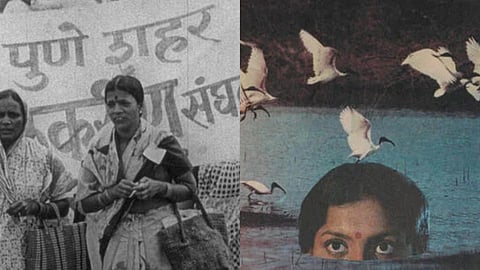
- HOMEGROWN WORLD
- #HGCREATORS
- #HGEXPLORE
- #HGVOICES
- #HGSHOP
- CAREERS
- ABOUT US
- CONTACT US

In his book India After Gandhi, the great historian Ramachandra Guha quotes British journalist Don Taylor. Writing in 1969, he says:
When one looks at this vast country and its 524 million people...it seems incredible that one nation could ever emerge. It does not, often, seem like one country. And yet there is a resilience about India which seems an assurance of survival. There is something which can only be described as an Indian spirit. I believe it no exaggeration to say that the fate of Asia hangs on its survival.
Inside the walls of the Barbican, a nation unfolds. Not the India of glossy tourist brochures or sanitized Bollywood narratives, but a messier, more honest India — one grappling with its fractures, contradictions, and unfulfilled promises. The Imaginary Institution of India: Art 1975–1998 is a sprawling exhibition that seeks to map the pulse of a country at its most turbulent, threading together decades of art, upheaval, and resilience.
This is not the kind of exhibition you would stumble upon in an Indian gallery, and therein lies a paradox. In India, where the past is often politicized and the present sanitized, an exhibition like this — one that unabashedly interrogates communal violence, caste oppression, and the perils of modernity — would struggle to find a home. Abroad, however, it thrives, inviting audiences to witness the raw and complex realities that India itself often prefers to relegate to the shadows.
The exhibition spans 23 years, beginning with the Emergency of 1975, when civil liberties were suspended, and culminating in 1998, when India detonated nuclear bombs. It is a timeline that simultaneously feels expansive and claustrophobic, filled with moments of aspiration and despair, progress and regression.
Gulammohammed Sheikh’s Speechless City evokes a post-apocalyptic eeriness with abandoned houses and foraging animals, capturing the suffocating atmosphere of the Emergency. Rummana Hussain’s shattered terracotta pots echo the fractured unity of a nation. These works are visceral, urgent pleas for introspection.
Why does an exhibition like this resonate so powerfully abroad, yet seem almost impossible in its country of origin? In part, it’s because the questions these artworks pose — about caste, religion, gender, and nationalism — are ones that India often struggles to confront head-on.
Bhupen Khakhar’s Two Men in Benares is a tender depiction of queer love set against the spiritual backdrop of Varanasi. When first exhibited in Mumbai in 1987, it had to be removed after just two days due to fears of protest. Today, in a London gallery, it’s celebrated as groundbreaking, a reminder of how spaces for dissent and dialogue are often more accessible outside the country they critique.
Navjot Altaf’s Emergency Poster channels the anger of a generation, drawing from Cuban political propaganda to rally against corruption and state violence. Vivan Sundaram’s installations, crafted from mirrors and rubble, turn everyday objects into symbols of collective trauma. These works, created decades ago, feel prescient, their themes echoing in India’s current climate.
The exhibition doesn’t present India as a singular narrative but as a multitude. Its complexities are captured like in Arpita Singh’s My Mother, where the chaos of communal violence spills into the dignity of domestic life.
Exhibitions like this are crucial — not just for the diaspora but for the world. They offer a nuanced glimpse into the heart of a country that often defies understanding, inviting viewers to wrestle with its contradictions. They also highlight the role of foreign institutions in preserving and amplifying voices that might otherwise be stifled.
In Tyeb Mehta’s Durga Mahisasura Mardini, the goddess triumphs over chaos. You’re struck by the symbolism — not just of the painting, but of the exhibition itself. This is what India could be: a space where the past isn’t rewritten but reckoned with. But for now, that India exists only in places like the Barbican. Perhaps that’s the greatest tragedy — and the greatest hope — of The Imaginary Institution of India. It’s a mirror held up to a nation, but the question remains: Will India ever dare to look?
The Imaginary Institution of India is on view till January 5, 2024 at the Barbican Centre, London.
Learn more here.
If you enjoyed reading this, here's more from Homegrown:
From Amitav Ghosh's To Shailaja Paik, 2024 Was A Watershed Year For Indian Literature
An Upcoming Music Festival Is Creating A Women-Only Space At Their New Year's Event
A Pioneer Of Indian Parallel Cinema: Iconic Filmmaker Shyam Benegal Passes Away At 90
